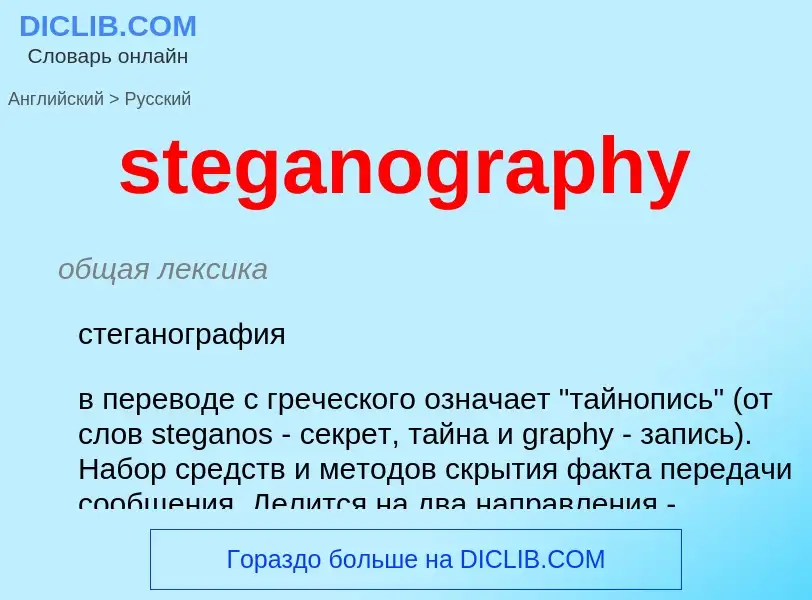Translation and analysis of words by ChatGPT artificial intelligence
On this page you can get a detailed analysis of a word or phrase, produced by the best artificial intelligence technology to date:
- how the word is used
- frequency of use
- it is used more often in oral or written speech
- word translation options
- usage examples (several phrases with translation)
- etymology
steganography - translation to russian
общая лексика
стеганография
в переводе с греческого означает "тайнопись" (от слов steganos - секрет, тайна и graphy - запись). Набор средств и методов скрытия факта передачи сообщения. Делится на два направления - лингвистическое и технологическое. Технологическая стеганография занимается маскированием сообщений, используя такие приёмы как тайнопись, микроточки, кодирование сообщения в графических и звуковых файлах и т.д. У технологической стеганографии существует множество разных направлений: цифровая стеганография, радиоэлектронная стеганография, компьютерная стеганография и др. Лингвистические стеганограммы делятся на две основные категории - условное письмо и семаграммы
[krip'tɔlədʒi]
общая лексика
криптология
наука о создании и анализе систем безопасного хранения и передачи информации. Термин используется для обозначения всей области секретной связи. Происходит от слов cryptos - тайный и logos - сообщение. Делится на три направления: криптографию (cryptography), стеганографию (steganography) и криптоанализ (cryptoanalysis)
существительное
общая лексика
криптология
наука о расшифровке тайнописи
синоним
Definition
Wikipedia
Steganography ( (listen) STEG-ə-NOG-rə-fee) is the practice of representing information within another message or physical object, in such a manner that the presence of the information is not evident to human inspection. In computing/electronic contexts, a computer file, message, image, or video is concealed within another file, message, image, or video. The word steganography comes from Greek steganographia, which combines the words steganós (στεγανός), meaning "covered or concealed", and -graphia (γραφή) meaning "writing".
The first recorded use of the term was in 1499 by Johannes Trithemius in his Steganographia, a treatise on cryptography and steganography, disguised as a book on magic. Generally, the hidden messages appear to be (or to be part of) something else: images, articles, shopping lists, or some other cover text. For example, the hidden message may be in invisible ink between the visible lines of a private letter. Some implementations of steganography that lack a shared secret are forms of security through obscurity, and key-dependent steganographic schemes adhere to Kerckhoffs's principle.
The advantage of steganography over cryptography alone is that the intended secret message does not attract attention to itself as an object of scrutiny. Plainly visible encrypted messages, no matter how unbreakable they are, arouse interest and may in themselves be incriminating in countries in which encryption is illegal.
Whereas cryptography is the practice of protecting the contents of a message alone, steganography is concerned with concealing the fact that a secret message is being sent and its contents.
Steganography includes the concealment of information within computer files. In digital steganography, electronic communications may include steganographic coding inside of a transport layer, such as a document file, image file, program, or protocol. Media files are ideal for steganographic transmission because of their large size. For example, a sender might start with an innocuous image file and adjust the color of every hundredth pixel to correspond to a letter in the alphabet. The change is so subtle that someone who is not specifically looking for it is unlikely to notice the change.

![A chart from [[Johannes Trithemius]]'s ''[[Steganographia]]'' copied by [[Dr John Dee]] in 1591 A chart from [[Johannes Trithemius]]'s ''[[Steganographia]]'' copied by [[Dr John Dee]] in 1591](https://commons.wikimedia.org/wiki/Special:FilePath/Chart in the hand of Dr John Dee. Steganographiae.png?width=200)

![A [[microdot]] camera A [[microdot]] camera](https://commons.wikimedia.org/wiki/Special:FilePath/Microdot camera markiv.jpg?width=200)



![French]] cipher machine, with arms of [[Henri II of France]] French]] cipher machine, with arms of [[Henri II of France]]](https://commons.wikimedia.org/wiki/Special:FilePath/16th century French cypher machine in the shape of a book with arms of Henri II.jpg?width=200)
![First page of a book by [[Al-Kindi]] which discusses encryption of messages First page of a book by [[Al-Kindi]] which discusses encryption of messages](https://commons.wikimedia.org/wiki/Special:FilePath/Al-kindi cryptographic.png?width=200)
![[[Whitfield Diffie]] and [[Martin Hellman]], authors of the first published paper on public-key cryptography. [[Whitfield Diffie]] and [[Martin Hellman]], authors of the first published paper on public-key cryptography.](https://commons.wikimedia.org/wiki/Special:FilePath/Diffie and Hellman.jpg?width=200)
![Enciphered letter from [[Gabriel de Luetz d'Aramon]], [[French Ambassador to the Ottoman Empire]], after 1546, with partial decipherment Enciphered letter from [[Gabriel de Luetz d'Aramon]], [[French Ambassador to the Ottoman Empire]], after 1546, with partial decipherment](https://commons.wikimedia.org/wiki/Special:FilePath/Encoded letter of Gabriel Luetz d Aramon after 1546 with partial deciphering.jpg?width=200)
![Cipher Bureau]], for 7 years before the war, and subsequent decryption at [[Bletchley Park]], was important to Allied victory.<ref name="kahnbook" /> Cipher Bureau]], for 7 years before the war, and subsequent decryption at [[Bletchley Park]], was important to Allied victory.<ref name="kahnbook" />](https://commons.wikimedia.org/wiki/Special:FilePath/Enigma.jpg?width=200)

![Reconstructed [[ancient Greek]] ''[[scytale]]'', an early cipher device Reconstructed [[ancient Greek]] ''[[scytale]]'', an early cipher device](https://commons.wikimedia.org/wiki/Special:FilePath/Skytala&EmptyStrip-Shaded.png?width=200)
